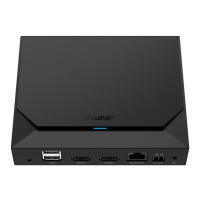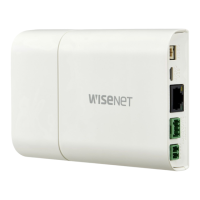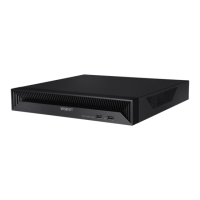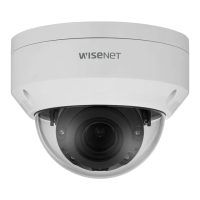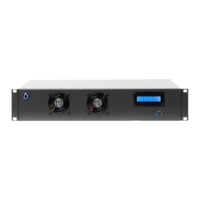Do you have a question about the Hanwha Techwin Wisenet Series and is the answer not in the manual?
| Brand | Hanwha Techwin |
|---|---|
| Model | Wisenet Series |
| Category | DVR |
| Language | English |
Read and follow all operating instructions and safety warnings carefully before use.
Outlines the functionalities users can perform with the product.
Covers initial system setup, including the installation wizard and password configuration.
Configure network settings such as IP type, subnet mask, gateway, and DNS.
Provides steps for safely powering down the NVR system.
Describes the process for logging into the NVR menu with user credentials.
Explains the meaning of various status and operation icons on the live screen.
Lists common error messages and potential solutions or actions.
Describes the context menu that appears in Live split mode.
Details the context menu accessed by right-clicking on the live screen.
Outlines menu options specific to Single Mode operation.
Explains how to use the launcher menu at the bottom of the live screen.
Instructions on how to change the screen display mode.
Guides on splitting live video into different display configurations.
Enables sequential monitoring of split modes at set intervals.
How to navigate between split modes using arrow keys or a remote controller.
Displays connection details for cameras on the live screen.
Checks transmitted data from cameras connected to each channel.
View channel profiles, record types, and data transfer amounts.
Checks the current PoE status for each port on the device.
Display a channel in a specific area of a split screen.
Steps to magnify or shrink the video using the remote controller or mouse wheel.
Utilizes D-PTZ functionality for compatible cameras.
Select and arrange channels into custom layouts for monitoring.
Controls sound output for selected channels in Live mode.
Temporarily pauses the live video feed.
Synchronizes channel display with specific events like motion or sensor triggers.
Captures a snapshot of the live screen for selected channels.
Adjusts the screen ratio for all channels simultaneously.
Adjusts the screen ratio for a specific selected channel.
Enables displaying text data from POS systems on the live screen.
Activates PTZ control for selected channels.
Guides on initiating PTZ control via menus or screen icons.
Perform PTZ operations and configure custom preset settings for cameras.
Steps to save a specific camera view as a preset position.
How to modify or remove existing preset camera positions.
Search for backup devices and initiate video recording backup.
Configuration for system settings including date, time, language, users, properties, and logs.
Set device date, time, time zone, language, and synchronization.
Manage user accounts and permissions for accessing NVR functions.
Configure the administrator ID and password for system access.
Create user groups and assign specific permissions to them.
Procedure to add a new user group.
Define access rights for users within each group.
Steps to add a new user account.
Configure restricted access levels for general users.
Procedure to remove groups and user data.
Explains limitations for users in groups with restricted access.
How users with restricted access can change their own password.
View current system details like model name, software version, and MAC address.
Steps to update the NVR's software using external media or network.
Import/export NVR configuration settings using storage media.
Review logs detailing system startups, shutdowns, and settings changes.
Search for recorded events such as alarms, camera events, and video loss.
Review backup history including user, time, channel, and device.
Configure settings related to connected network cameras.
Add network cameras to the NVR and establish their connection.
Automatic process to find and add network cameras.
Manual process to find and add network cameras.
Specific steps for registering cameras on PoE-enabled devices.
Select camera address type (Static, DDNS, URL).
Explains common errors encountered during camera registration.
Modify camera profiles for live, recording, and network settings.
Configure advanced settings for ONVIF-compliant cameras.
Configure event detection and mapping for cameras.
Set specific video profiles for each camera channel.
Configure camera settings while viewing live video.
Adjust settings like DIS, Defog, Flip, Privacy, SSDR, Backlight, Exposure, Day/Night, Dewarping.
Optimize video compression and data size using WiseStream.
Automatically adjust GOV and FPS based on video conditions.
Modify live video transfer settings for network cameras.
Configure specific video settings for each camera channel.
Manage devices like iSCSI, RAID, HDD Alarm, Distributed Recording, and Monitor settings.
Steps to connect an NVR to an iSCSI device.
Details RAID levels supported by different NVR products.
Instructions for using and configuring RAID mode.
Procedures for replacing malfunctioning HDDs and restoring RAID arrays.
Configure remote controller ID settings for NVR operation.
Adjust monitor output displays, switching times, and video settings.
Configure settings for an additional or extended monitor.
Change the display position of information elements on the monitor.
Configure relevant values for devices connected to the NVR.
Set total amount conditions and keywords for receiving alarms.
Schedule recording events for specific dates and times.
Set resolution, IPS, and recording quality for channels and event types.
Manage HDD behavior when full: stop or overwrite.
Configure sensor operation modes, connected cameras, and alarm outputs.
Set NVR/camera event modes, alarm outputs, and timing.
Define video analysis areas like virtual lines, intrusion zones, and exit zones.
Set up network connection routes and protocols.
Configure network protocol and environment settings.
Connect and configure network settings based on your environment.
Set up Dynamic DNS for remote access using a domain name.
Manage lists of IP addresses to allow or block network access.
Select security connection systems or install public certificates for secure communication.
Configure 802.1x protocol and install certificates for network security.
Set video profiles for network transmission and expansion monitors.
Send event emails to registered users and recipient groups.
Configure SMTP server details and authentication process.
Set up the internal DHCP server and assign IP addresses to network cameras.
View assigned IP, MAC, and network port information from the DHCP server.
Manage screen printout, audio, OSD, aspect ratio, full screen, and timeline controls.
Utilize remote controller functions for NVR operation.
How to use numeric buttons for channel selection.
Match remote control ID with NVR ID for proper operation.
Input characters using the on-screen virtual keyboard.

